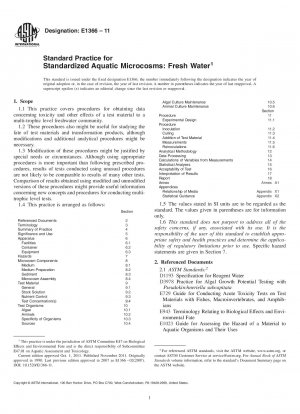ASTM E1366-11
Standard Practice for Standardized Aquatic Microcosms: Fresh Water
- Standard No.
- ASTM E1366-11
- Release Date
- 2011
- Published By
- American Society for Testing and Materials (ASTM)
- Status
- Replace By
- ASTM E1366-11(2016)
- Latest
- ASTM E1366-23
- Scope
A microcosm test is conducted to obtain information concerning toxicity or other effects of a test material on the interactions among three trophic levels (primary, secondary, and detrital) and the competitive interactions within each trophic level. As with most natural aquatic ecosystems, the microcosms depend upon algal production (primary production) to support the grazer trophic level (secondary production), which along with the microbial community are primarily responsible for the nutrient recycling necessary to sustain primary production. Microcosm initial condition includes some detritus (chitin and cellulose) and additional detritus is produced by the system. The microcosms include ecologically important processes and organisms representative of ponds and lakes, but are non-site specific.
The species used are easy to culture in the laboratory and some are routinely used for single species toxicity tests (Guide E729; Practice D3978, Guides E1192 and E1193). Presumably acute toxicity test results with some of these species would be available prior to the decision to undertake the microcosm test. If available, single species toxicity results would aid in distinguishing between indirect and direct effects.
These procedures are based mostly on previously published methods (4-6), interlaboratory testing (7-10), intermediate studies (11-22), statistical studies (23-25) and mathematical simulation results (26). Newer studies on jet fuels have been reported (27)(See 15.1 for multivariate statistical analyses) and on the implications of multispecies testing for pesticide registration (28). Environmental Protection Agency, (EPA) and Food and Drug Administration, (FDA) published similar microcosm tests (29). The methods described here were used to determine the criteria for Acceptable Tests (Section 16).
Concurrent to measuring the ecological effects, it is advisable to measure the concentration of the parent test chemical, and if possible, the transformation products ((30) see Section 12). The concentrations can be measured on either the same microcosms or on concurrent replicates. Information on the chemical concentrations of parent material and transformation products would aid in the assessment of chemical persistence, exposure, accumulation, and in interpreting, if recovery is associated with chemical degradation or biological adaptation. This protocol deals only with ecological effects, because the techniques for fate studies are in general usage.
In the microcosm, as in natural ecosystems, a population must be able to obtain its requirements from the products of other trophic levels, to maintain a birth rate equal to or greater than its death rate, and to support populations of organisms that will remove its waste products. As in natural ecosystems, several organisms might be capable of fulfilling the same function, and shifts in species dominance can occur without disruption of an ecological process. However, species that are “ecological equivalents” in one function might not be “equivalent” in other functions; for example, a filamentous alga and a single cell alga might equally produce O2, remove NO3, NH3, and ..........
ASTM E1366-11 Referenced Document
- ASTM D1193 Standard Specification for Reagent Water
- ASTM D3978 Standard Practice for Algal Growth Potential Testing with Selenastrum Capricornutum
- ASTM E1023 Standard Guide for Assessing the Hazard of a Material to Aquatic Organisms and Their Uses
- ASTM E1192 Standard Guide for Conducting Acute Toxicity Tests on Aqueous Ambient Samples and Effluents with Fishes, Macroinvertebrates, and Amphibians
- ASTM E1193 Standard Guide for Conducting
Daphnia magna Life-Cycle Toxicity Tests - ASTM E729 Standard Guide for Conducting Acute Toxicity Tests on Test Materials with Fishes, Macroinvertebrates, and Amphibians
- ASTM E943 Standard Terminology Relating to Biological Effects and Environmental Fate
- IEEE SI 10 American National Standard for Metric Practice
ASTM E1366-11 history
- 2023 ASTM E1366-23 Standard Practice for Standardized Aquatic Microcosms: Fresh Water
- 2011 ASTM E1366-11(2016) Standard Practice for Standardized Aquatic Microcosms: Fresh Water
- 2011 ASTM E1366-11 Standard Practice for Standardized Aquatic Microcosms: Fresh Water
- 2002 ASTM E1366-02(2007) Standard Practice for Standardized Aquatic Microcosms: Fresh Water
- 2002 ASTM E1366-02 Standard Practice for Standardized Aquatic Microcosms: Fresh Water
- 1996 ASTM E1366-96 Standard Practice for Standardized Aquatic Microcosms Fresh Water
